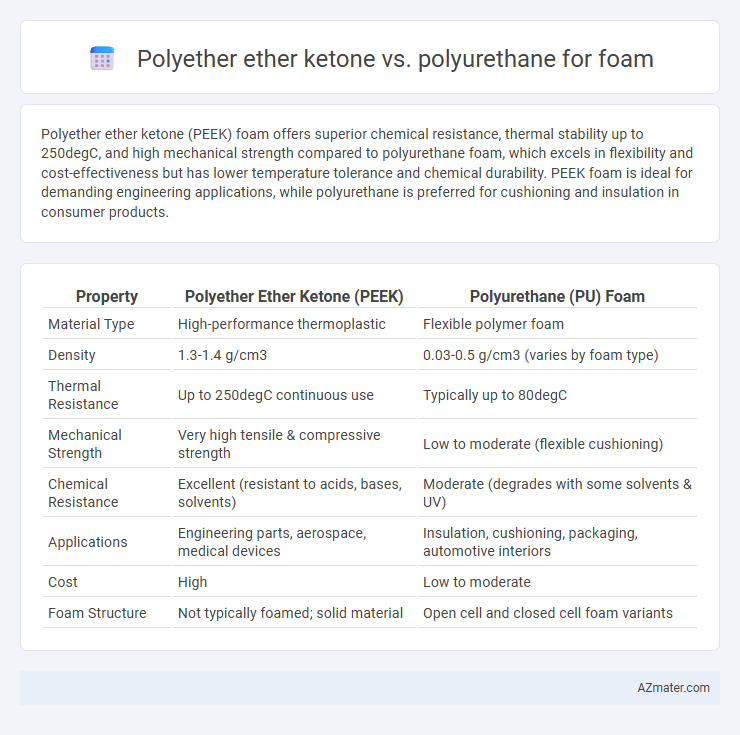Polyether ether ketone (PEEK) foam offers superior chemical resistance, thermal stability up to 250degC, and high mechanical strength compared to polyurethane foam, which excels in flexibility and cost-effectiveness but has lower temperature tolerance and chemical durability. PEEK foam is ideal for demanding engineering applications, while polyurethane is preferred for cushioning and insulation in consumer products.
Table of Comparison
| Property | Polyether Ether Ketone (PEEK) | Polyurethane (PU) Foam |
|---|---|---|
| Material Type | High-performance thermoplastic | Flexible polymer foam |
| Density | 1.3-1.4 g/cm3 | 0.03-0.5 g/cm3 (varies by foam type) |
| Thermal Resistance | Up to 250degC continuous use | Typically up to 80degC |
| Mechanical Strength | Very high tensile & compressive strength | Low to moderate (flexible cushioning) |
| Chemical Resistance | Excellent (resistant to acids, bases, solvents) | Moderate (degrades with some solvents & UV) |
| Applications | Engineering parts, aerospace, medical devices | Insulation, cushioning, packaging, automotive interiors |
| Cost | High | Low to moderate |
| Foam Structure | Not typically foamed; solid material | Open cell and closed cell foam variants |
Introduction to PEEK and Polyurethane Foams
Polyether ether ketone (PEEK) is a high-performance thermoplastic known for its exceptional mechanical strength, chemical resistance, and thermal stability, making it suitable for demanding industrial applications. Polyurethane foams, derived from the reaction of polyols and isocyanates, offer versatility in density, flexibility, and cushioning properties commonly used in insulation, automotive, and furniture industries. While PEEK excels in structural applications requiring durability and high-temperature resistance, polyurethane foams provide lightweight, energy-absorbing solutions with customizable physical properties.
Chemical Structure Comparison
Polyether ether ketone (PEEK) features a semi-crystalline aromatic polymer structure characterized by repeating ketone and ether functional groups, providing high thermal stability and chemical resistance. Polyurethane foam consists of urethane linkages formed from the reaction between polyols and isocyanates, resulting in a flexible polymer network with versatile mechanical properties. The rigid aromatic backbone of PEEK contrasts with the segmented soft and hard domains in polyurethane, influencing their respective applications in high-performance and cushioning materials.
Mechanical Properties: Strength and Flexibility
Polyether ether ketone (PEEK) exhibits superior mechanical strength and high-temperature resistance compared to polyurethane foam, making it suitable for demanding structural applications. Polyurethane foam offers greater flexibility and cushioning due to its elastomeric properties, providing excellent energy absorption and resilience. The choice between PEEK and polyurethane foam depends on the balance required between rigidity and flexibility, with PEEK favored for strength and thermal stability, while polyurethane excels in impact damping.
Thermal Stability and Temperature Resistance
Polyether ether ketone (PEEK) exhibits superior thermal stability and temperature resistance compared to polyurethane foams, maintaining structural integrity at temperatures up to 250degC or higher while polyurethane typically degrades beyond 120degC. PEEK's crystalline structure and strong aromatic bonds provide exceptional resistance to thermal decomposition, making it ideal for high-temperature applications in aerospace and automotive industries. In contrast, polyurethane foams are more susceptible to thermal oxidation and softening, limiting their use to moderate temperature environments.
Durability and Longevity in Applications
Polyether ether ketone (PEEK) foam demonstrates superior durability and longevity compared to polyurethane foam, maintaining structural integrity under high temperatures and chemical exposure up to 250degC. PEEK's resistance to wear, solvents, and mechanical stress makes it ideal for demanding aerospace and automotive applications requiring long-term performance. Polyurethane foam, while cost-effective and flexible, tends to degrade faster under UV exposure, moisture, and abrasion, limiting its lifespan in harsh environments.
Processing Methods and Manufacturing
Polyether ether ketone (PEEK) foam is typically produced using high-temperature compression molding and advanced sintering techniques, enabling precise control over porosity and mechanical strength for high-performance applications. In contrast, polyurethane foam manufacturing relies on chemical foaming through reaction injection molding (RIM) or slabstock processes, which are faster and more cost-effective but offer less thermal stability and mechanical robustness than PEEK foams. PEEK processing requires specialized equipment and controlled environments due to its melting point above 340degC, whereas polyurethane can be processed at lower temperatures, facilitating versatile shaping and scalability in mass production.
Cost Analysis: PEEK vs Polyurethane
Polyether ether ketone (PEEK) exhibits significantly higher material and processing costs compared to polyurethane foam due to its advanced thermal stability and mechanical properties suitable for demanding industrial applications. Polyurethane foam remains a cost-effective choice for cushioning and insulation, offering lower raw material and manufacturing expenses. Selecting between PEEK and polyurethane involves balancing performance requirements against budget constraints, with polyurethane favored for economic efficiency in large-scale production.
Environmental Impact and Sustainability
Polyether ether ketone (PEEK) offers superior chemical resistance and durability but has a higher environmental footprint due to energy-intensive manufacturing processes and limited recyclability compared to polyurethane (PU) foam. Polyurethane foam, widely used in cushioning and insulation, often incorporates recycled materials and can be formulated for improved biodegradability, enhancing its sustainability profile. In terms of lifecycle assessment, PU foam generally demonstrates a lower carbon footprint and greater end-of-life options, making it a more environmentally favorable choice for foam applications.
Common Applications in Industry
Polyether ether ketone (PEEK) is widely used in aerospace, automotive, and medical industries for high-performance applications requiring chemical resistance and thermal stability. Polyurethane foam is prevalent in furniture, automotive seating, insulation, and packaging due to its flexibility, cushioning properties, and cost-effectiveness. Industrial sectors choose PEEK for structural components and polyurethane foam for lightweight padding and insulation solutions.
Conclusion: Choosing the Right Material for Foam
Polyether ether ketone (PEEK) offers exceptional chemical resistance, high-temperature stability, and superior mechanical strength, making it ideal for demanding foam applications requiring durability and longevity. Polyurethane (PU) provides excellent flexibility, cushioning properties, and cost-effectiveness, suitable for comfort-oriented and lightweight foam products. Selecting the right material depends on application-specific requirements, balancing performance factors such as thermal resistance and mechanical endurance with budget and flexibility needs.

Infographic: Polyether ether ketone vs Polyurethane for Foam
 azmater.com
azmater.com